Availability of electricity is a regular part of daily life for most, but there are still parts of the world where access to electricity is not a given. Further aggravating the issue is the increasing number of man-made and natural disasters that are testing the limits of how to provide basic illumination for a significant part of the world population. The following roundup of products offer inventive illumination solutions by using an array of resources such as solar energy, salt water, and even gravity. The result is a new category of lighting options focused on portability and ease of operation to provide light no matter the location or circumstance.
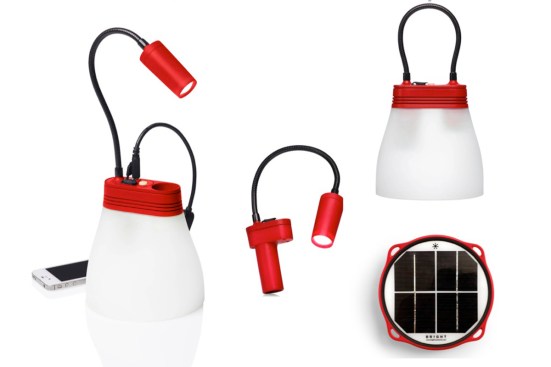
Courtesy Bright Products
SunBell Solar LED Lamp and Phone Charger by Bright Products
SunBell Solar LED Lamp and Phone Charger, Bright Products
Developed by Norwegian company Bright Products, this portable LED lamp is designed to provide “simple and sustainable power solutions.” The company’s core market “… is the 1.3 billion people living without access to electricity in Africa, Asia and South America, and among them, the millions of refugees and displaced people depending on Aid & Relief organizations.”
The lantern uses sunlight as the energy source to charge the LiFePO4 battery which in turn illuminates three high power LEDs through a 1.8W solar panel. After the solar panel has been fully charged (natural light exposure for 4 to 8 hours), it can provide 4.5-plus hours to 100-plus hours of light depending on its mode (Bright, Medium, or Low). The lumen output is 100, 20, and five, respectively. The lantern measures 15 cm by 15 cm by 20 cm (5.9″ by 5.9″ by 7.8″), weighs 600 grams (1.3 lbs.), and has a nine-foot charging cable that rolls up into the solar module. It also has a USB adapter that is suitable for charging most cell phones. Available with red, yellow, or green accent colors. bright-products.com
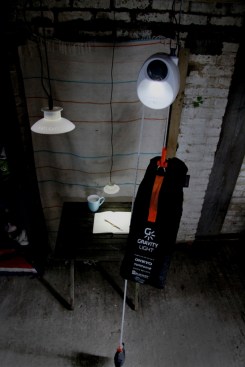
GL01, GravityLight Foundation
Developed by the GravityLight Foundation, based in the United Kingdom, and whose mission it is to eliminate kerosene lamps and their damaging effects, this luminaire offers an alternative to fixtures powered by batteries and sunlight. Using the earth’s gravitational force, the device, which uses an LED for its light source, is installed at its hanging point. It uses a weight (max load is 12.5 kg or 27.5 lbs.) and a pulley system. Once the weight has reached the underside of the light source enclosure it is released and descends slowly using kinetic energy through a drive sprocket and a polymer gear train to power a DC generator. The run time per each illumination cycle is 20 minutes (based on a 6-foot drop distance according to the company), and the device provides a light output of 16 lumens. Gravity Light can operate in temperature conditions between minus 5˚C and plus 40˚C. gravitylight.org
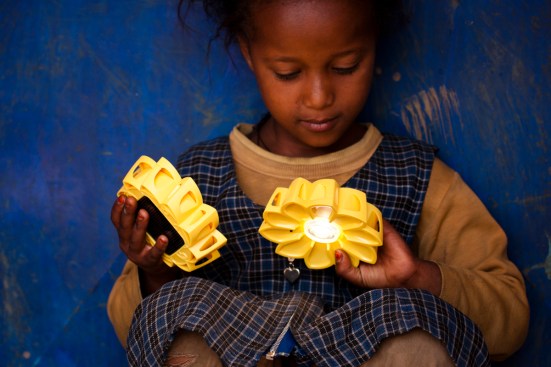
Courtesy Studio Olafur Eliasson
Little Sun Original by Studio Olafur Eliasson
Little Sun Original, Studio Olafur Eliasson
Little Sun was founded in 2012 by artist Olafur Eliasson and engineer Frederik Ottesen as an artist-designed product that could also serve as a social business model to offer a sustainable lighting solution for those without access to energy. The project initially launched in Ethiopia, and has since expanded to communities worldwide.
The portable solar LED lamp is shaped like a sunflower and made from recyclable ABS plastic. It measures 12 cm in diameter by 2.9 cm deep (4.7” by 1.14”) and weighs just 96 grams (0.21lbs.). It is powered using an AA LiFePO4, 3.2V rechargeable battery and a 60 mm by 60 mm (2.36″ by 2.36″) monocrystalline solar panel to run the 4500K LEDs. Using a button operation for on/off function, when the button is held down, dimming functionality is activated. When charged for five hours, Little Sun can provide four hours of bright light at 25 lumens; using the dimming function it can provide up to 5 hours of illumination at the lowest setting of 2 lumens. The housing is UV and weather resistant. littlesun.com
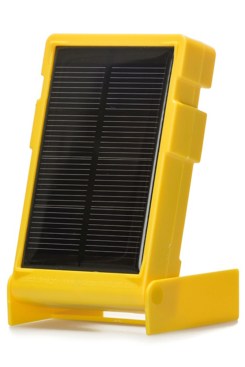
Courtesy Waka Waka
WakaWaka Light by Waka Waka

WakaWaka Light, Waka Waka
WakaWaka is “a social impact company on a mission to provide universal access to the abundant energy of the sun.” The phrase WakaWaka means “shine bright” in Swahili. Using Kickstarter as the fundraising outlet, the purchase of a lamp, in turn, provides one lamp to an individual who is “…living through a humanitarian crisis” such as individuals who have been effected by the “…catastrophic earthquakes in Nepal, Haiti and the Philippines; [and] families displaced by war and strife…”.
Simple and sturdy in its 100% recycled ABS plastic and high-impact, resistant-build, WakaWaka is a solar-powered LED flashlight that can be used anywhere and provides up to 80 hours of illumination after charging in sunlight (5 to 10 hours). The device measures 116mm by 64 mm by 14 mm (4.5″ by 6.4″ by 0.55″) and weighs 130 grams (0.28 lbs.). It uses two focused LEDs that have a light output of 110 lumens per watt. The 750mWatt 18% monocrystalline solar panel uses a NiMh battery. It has three settings: Bright (8 hours > 25 lumen); Medium (16 hours > 12.5 lumen); and Energy Save (80 hours > 5 lumen). The light features an automatic energy saving mode, and an SOS emergency beacon. WakaWaka is available in yellow and gray. us.waka-waka.com
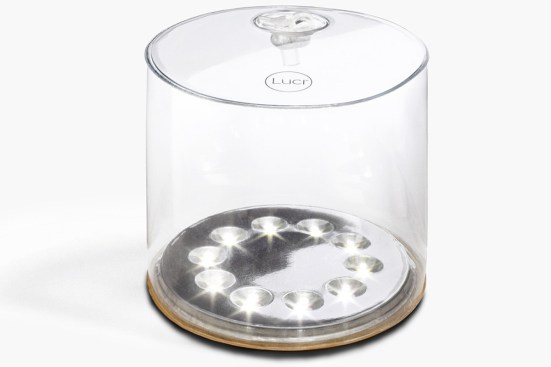
Courtesy MPowered
Luci Original by MPowered
Luci Original, MPowered
This lightweight (4.4 oz.), inflatable solar light can fit just about anywhere. Suitable for both indoor and outdoor use, the IP67-rated luminaire has a solar panel under its base, so it can be collapsed (2.5cm tall/0.98″) and turned upwards to charge during the day. The top of the base has 10 ultra-bright LEDs, each of which provide 50 lumens. After seven hours in direct sunlight, Luci is able to provide up to 12 hours of illumination on its brightest setting. It also has a bright setting and a 1 second flashing mode. It uses a Lithium-ion rechargeable battery and has an operating temperature of 15°F to 122°F (-10°C to 50°C). mpowerd.com
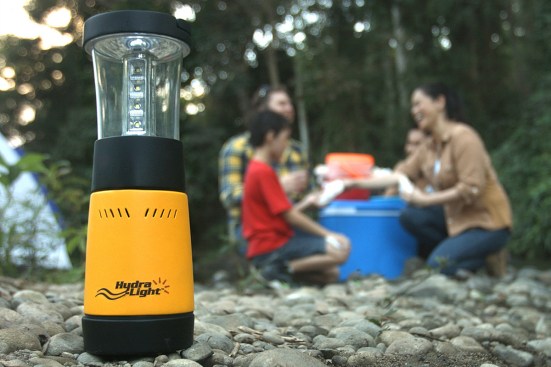
Courtesy HydraLight
The Hydra-Light Saltwater Charger & Light (PL-500) by HydraLight
The Hydra-Light Saltwater Charger & Light (PL-500), HydraLight
The Hydra-Light Saltwater Charger & Light (PL-500) is a battery-free portable LED lamp that is powered by a saltwater energy cell. The creation of the lamp “…evolved from [the company’s] search for a portable, safe and ecologically friendly alternative to battery powered lighting and charging products.” By adding water and table salt, the user is able to illuminate 16 long-life LEDs for 250-plus hours. The device measures 11.7″ high by 3.8″ in diameter. Additionally, a standard USB port can charge external devices such as cell phones. PL-500 is made of recyclable materials, and comes with a lightweight accessory 3 LED pucklight that can be plugged into the USB port via a 30-foot cable and illuminate areas up to 30 feet away. www.hydra-light.com
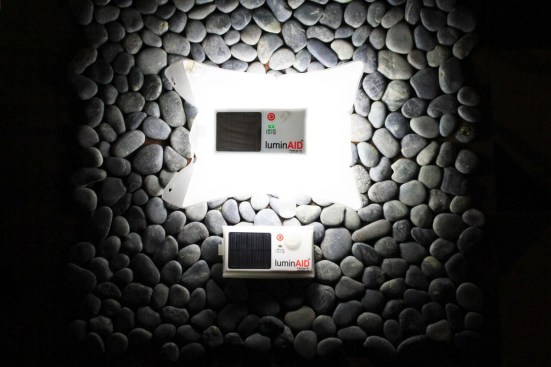
Courtesy LuminAid
PackLite 16 by LuminAid
PackLite 16, LuminAid
In 2010, after the earthquake in Haiti, then architecture graduate students Anna Stork and Andrea Sreshta were asked to design a product to assist post-earthquake relief efforts in Haiti. Their combined interests in “…solar lighting technology and a common belief that design and design thinking can be used to solve problems at a global scale, including improved access to basic resources such as lighting and power” launched LuminAid.
The inflatable PackLite 16 folds to the size of a wallet and can easily fit in a first aid kit or a backpack. It measures 5” by 3” by 0.25” when folded and weighs only 2.9 ounces. It is waterproof up to 1 meter (3.3 feet) deep, and floats. The durable thermoplastic polyurethane-encased LED luminaire uses a high efficiency 19% monocrystalline solar panel for power and is capable of charging in overcast conditions. The PackLite takes about 7 to 10 hours to fully charge, and once it has, it can provide 30 hours of illumination—from two extra bright LEDs— on its low setting (20 lumens, 16 hours). It also has an Extra Bright (65 lumens, 6 hours), High (35 lumens, 8 hours), and Flashing (20 lumens, 32 hours) mode. The maximum light output is 65 lumens. luminaid.com